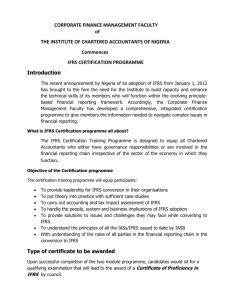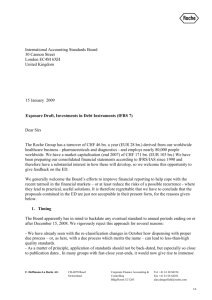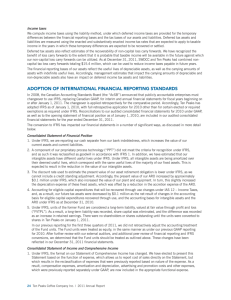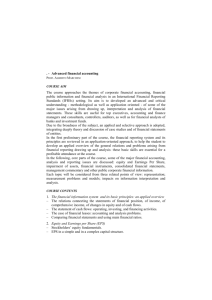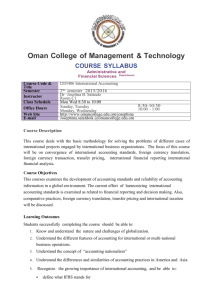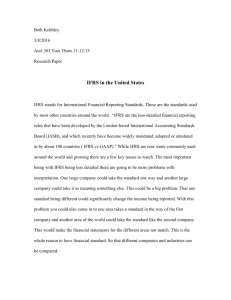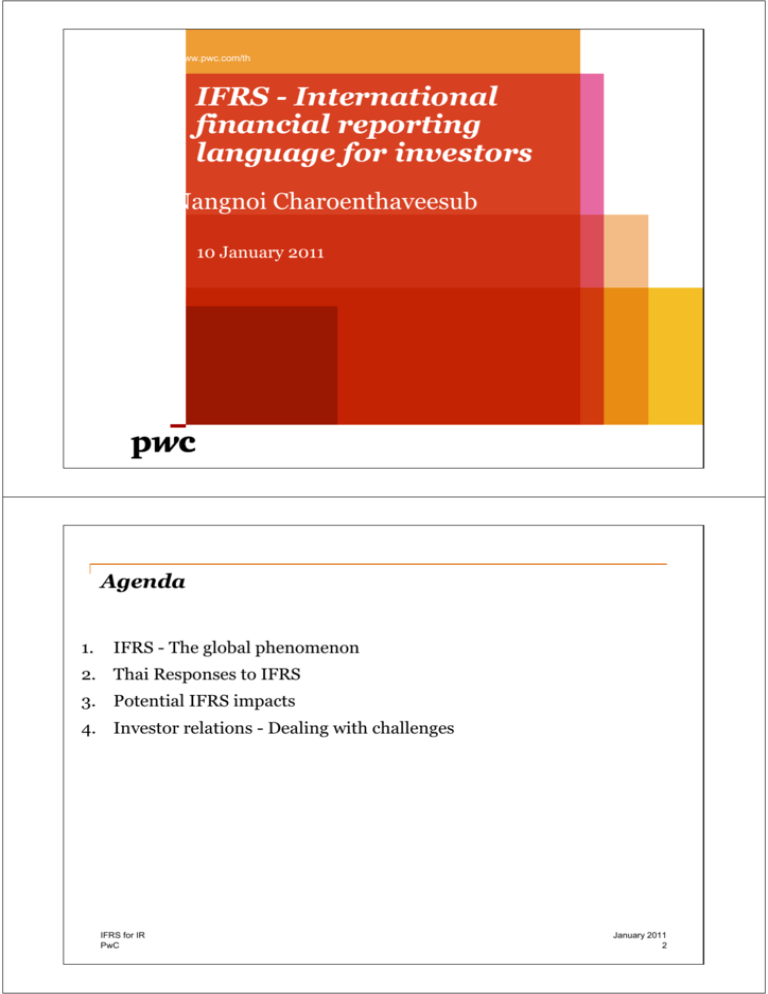
www.pwc.com/th
IFRS - International
financial reporting
language for investors
Nangnoi Charoenthaveesub
10 January 2011
Agenda
1.
IFRS - The global phenomenon
2. Thai Responses to IFRS
3. Potential IFRS impacts
4. Investor relations - Dealing with challenges
IFRS for IR
PwC
January 2011
2
IFRS - The global phenomenon
PwC
3
What is IFRS?
IFRS is the name of the international accounting standards set by the
International Accounting Standards Board (IASB) for the purpose of
developing a set of accounting standards accepted and complied with on a
global basis.
IFRS for IR
PwC
January 2011
4
Key features and benefits of IFRS
Key features of IFRS
• Principle - based
• Focus on Balance Sheet
• Fair Value Accounting
Improved
Transparency
in the business
performance
(accepted by all major
markets)
Improved
comparability (peer
comparison on a global
basis)
More extensive
disclosures
• Comparison of financial performance across boundaries
• More transparency and comparability
• Ability to raise funding at a cheaper cost
• Better information for strategic investment decision making
IFRS for IR
PwC
January 2011
5
IFRS - A global phenomenon
More than 100 countries require, permit or are converging to IFRS
The World's Top 15 Stock Exchanges by Domestic Market Capitalisation
- September 2010
Stock Exchange
to IFRS
IFRS adoption plan
Americas
2015 or 2016, subject to decision made in 2011
NASDAQ OMX
Americas
2015 or 2016, subject to decision made in 2011
London SE Group
EAME
2005
Tokyo SE
APAC
2015 or 2016, subject decision made in 2012.
NYSE Euronext (Europe)
EAME
2015 or 2016, subject to decision made in 2011
Hong Kong Exchanges
APAC
2005
Shanghai SE
APAC
Substantially converged national standards
TSX Group
Americas
2015 or 2016, subject to decision made in 2011
Bombay SE
APAC
2011
National Stock Exchange India
APAC
2011
BM&FBOVESPA
Americas
2015 or 2016, subject to decision made in 2011
Australian SE
APAC
Deutsche Börse
EAME
2005
BME Spanish Exchanges
EAME
2008
SIX Swiss Exchange
EAME
Not yet announced
NYSE Euronext (US)
Countries that require, permit or are converging
Economi
c area
2005
Source: www.pwc.com Update: January 2010
Source: World Federation of Exchanges
IFRS for IR
PwC
January 2011
6
Thai Responses to IFRS
PwC
7
IFRS adoption in Thailand
Partial IFRS financial statements starting from
Q1’2011
Comparative figures
required for 2011
financial statements
Date of IFRS
transition
1 Jan 2010
IFRS for IR
PwC
23 revised & 5 new
accounting standards
- effective 1 Jan 2011
onwards
Full IFRS financial
statements starting
from Q1’2013
4 revised & 4 new
accounting standards
- effective 1 Jan 2013
onwards
8
Thai GAAP moves towards IFRS
Effective for annual periods beginning on or after 1 January 2011
Revisions with no significant changes
Revisions with changes in some principle
No existing TASs/TFRSs
Accounting Framework
TAS 1: Presentation of FS
TAS 19: Employee benefits
TAS 2: Inventories
TAS 7: Cash flow statements
TAS 8: Accounting policies, changes in
accounting estimates and errors
TAS 16: Property, plant and equipment
TAS 26: Accounting & reporting by
retirement benefit plans
TAS 10: Events after the reporting
period
TAS 24: Related party disclosures
TAS 11: Construction contract
TAS 17: Leases
TAS 18: Revenue
TAS 34: Interim financial reporting
TAS 37: Provisions, contingent
liabilities and contingent assets
TAS 29: Financial Reporting in
Hyperinflationary Economies
TAS 23: Borrowing costs
TFRS 2: Share-based payment
TAS 27: Consolidated and separate FS
TFRS 6: Exploration for and
evaluation of mineral resources
TAS 28: Investment in associates
TAS 31: Interests in joint ventures
TAS 33: Earnings per share
TAS 36: Impairment of assets
TAS 38: Intangible assets
TAS 40: Investment property
TFRS 3: Business combinations
TFRS 5: Non-current assets held for sale
and discontinued operations
IFRS for IR
PwC
January 2011
9
Thai GAAP moves towards IFRS
Effective for annual periods beginning on or after 1 January 2013
Revision s with changes in some principle
TAS 20: Accounting for government grants &
disclosure of government assistance*
TAS 21: The effects of changes in foreign exchange
rates*
TAS 32: Financial instruments: presentation
TFRS 8: Operating segments
No existing TASs/TFRSs
TAS 12: Income taxes*
TAS 39: Financial instruments: recognition &
measurement
TFRS 4: Insurance contracts
TFRS 7: Financial instruments: disclosure
Not yet specify effective date
TFRS 1: First-time adoption of TFRSs
TAS 41: Agriculture
Remark:
* Announced in the Government Gazette
IFRS for IR
PwC
January 2011
10
Thai GAAP moves towards IFRS
Interpretation with the effective date during 2011 - 2013
IFRIC 1: Changes in existing decommissioning, restoration and similar liabilities
IFRIC 2: Members’ shares in cooperative entities and similar
IFRIC 4: Determining whether an arrangement contains a lease
IFRIC 5: Non-current assets held for sale and discontinued operations
IFRIC 8: Scope of IFRS 2 (Share-based payment)
IFRIC 9: Scope of IFRS 2
IFRIC 10: Interim financial reporting and impairment
IFRIC 11: IFRS 2 – Group and treasury share transactions
IFRIC 12: Service concession arrangements
IFRIC 13: Customer loyalty programmes
IFRIC 14: The limit on a defined-benefit asset, minimum funding requirements and their interaction
IFRIC 15: Arrangements for the construction of real estate (effective 1 January 2011)
IFRIC 16: Hedges of a net investment in a foreign operation
IFRIC 17: Distributions of non-cash assets
SIC 10: Government assistance – No specific relation to operating activities
SIC 12: Consolidation – Special-purpose entities
SIC 13: Jointly controlled entities – Non-monetary contributions by venturers
SIC 15: Operating leases – incentives
SIC 21: Income taxes – recovery of revalued Non-depreciable assets
SIC 25: Income taxes – changes in the tax status of an entity or its shareholders
SIC 27: Evaluating the substance of transactions involving the legal form of lease
SIC 29: Service concession agreements: Disclosure
SIC 31: Revenue – Barter transactions involving advertising services
SIC 32:Intangible assets – Web Site Cost
IFRS for IR
PwC
January 2011
11
Potential IFRS impacts and key
challenges
PwC
12
IFRS business transformation
Challenges you will face……
Scope & magnitude of
change
• Understand full impact on
organisation
• Identify required resources
Governance & compliance
• Set up IFRS project governance
structure
• Regular update to management
Change management
Stakeholder engagement
•Identify impacted stakeholders
(internal & external)
• Develop communication plan
• Education programme
Sustainability
• Understand impact on people, process
and IT
• Minimise lost opportunities to embed
change
• Take opportunity of IFRS change
into long-term finance &
operational effectiveness
IFRS for IR
PwC
January 2011
13
Potential areas of impact by IFRS
Conceptual
Conceptual illustration
illustration
High
Financial Statements Impact
Investments,
consolidation
(IAS27/28,
SIC12)
Business
combination
(IFRS3)
Employee
benefits
(IAS19)
Share based
payment
(IFRS 2)
Assets
disposals and
discontinued
operation
(IFRS5)
Impairment
of assets
(IAS36)
Leasing
(IAS17)
Fixed assets and
investment
property (IAS16,
40)
Income
taxes
(IAS12)
Revenue
recognition
& points
(IAS18)
Functional
currency
(IAS21)
Exploration for and
evaluation of
mineral resources
(IFRS6)
Financial
statement
presentation and
disclosure (IAS1)
Business/Operational Impact
Financial
instruments
IAS39 (IFRS9)
Segment
Financial
instruments
(IAS32,IFRS7)
Financial impact
High
Disclosure
IFRS for IR
PwC
Remark: For information purposes only, this may vary from client to client
January 2011
14
Profit and loss impact
For
For illustrative
illustrative purpose
purpose only
only
3,982
(I)
(A)
Cost of sales
(500)
(E), (F)
Gross profit
3,482
Consolidated statement of income
Sales
Selling & adminstrative expenses
Operating income
Non operating income
Non operating expenses
Extraordinary loss
Extraordinary expense
Profit before tax
Income taxes - deferred
Minority interest
Net income
(1,716)
(B),(C),(D),(E),
(F),(G),(H)
1,766
(A) Revenue recognition/points:- 1. Gross vs. net 2. Bundle sales
arrangement 3. Timing of recognition (shipment→delivery) 4.
Calculation of interest income (effective interest method)
(B) Business combination and Intangible assets:- 1. Goodwill
valuation and termination of amortisation 2. Timing of adoption
(C) Leases:- 1. Capitalisation of off-balance leases 2. Determination of
transactions deemed to be leases 3. Operating leases incentive
46
(42)
(G)
74
Removed
(98)
Removed
1,746
(6)
(D) Tangible assets:- 1. Component accounting 2. Asset retirement
obligations 3. Valuation of investment property 4. Impairment of assets
(E) Provisions: - 1. Liability reserve for insurance companies 2.
Adjustment to provision for loss on interest payment 3. Employee
benefit obligation
(5)
(F) Stock options:- 1. Application of fair value accounting 2.
Treatment of cancelled stock option
1,735
(G) Capitalisation of borrowing cost
(I) Scope of consolidation 1. Consolidation of operating
entities 2. Consolidation of SPEs
(H) Financial instruments:- 1. Classification 2. Measurement 3.
Hedge accounting 4. Gross/net presentation
IFRS for IR
PwC
January 2011
15
Change in presentation
Statement of comprehensive income
Consolidated statement of income
Sales
3,982
Cost of sales
(500)
Gross profit
3,482
Selling & adminstrative expenses
Operating income
Non operating income
Non operating expenses
Extraordinary loss
Extraordinary expense
Profit before tax
Income taxes - deferred
Minority interest
Net income
For
For illustrative
illustrative purpose
purpose only
only
(1,716)
1,766
46
(42)
74
(98)
1,746
(6)
(5)
1,735
Continued operations
Sales
Cost of sales
2,878
599
Gross profit
Selling, general and administrative expenses
Other operating income (expense)
2,279
1,755
(14)
Operating income
Financial income
Financial expense
Equity in earnings of unconsolidated subsidiaries
and affiliates
510
10
35
5
Profit before tax
Income tax expense
Net profit from continued operations
490
(89)
579
Discontinued operations
━
Loss on discontinued operations
Net income
Other comprehensive income
Comprehensive income
IFRS for IR
PwC
579
(1)
578
January 2011
16
For
For illustrative
illustrative purpose
purpose only
only
Balance sheet impact
Consolidated balance sheet
Assets
(J)
Current assets
18,141
(A)
Fixed assets
2,239
(B),(C)
Intangible assets
2,212
(D)
Total assets
(A) Financial instruments:- 1. Classification 2. Measurement
3. Hedge accounting 4. Gross/net presentation
(B) Tangible:- 1. Component accounting 2. Asset retirement
obligations 3. Valuation of investment property 4. Impairment
of assets
(C) Leases:- 1. Capitalisation of off-balance leases 2.
Determination of transactions deemed to be leases
22,592
Liabilities
Current liabilities
Long term liabilities (including reserve
required under the special law)
Total liabilities
15,670
(E),(F),(G),(H)
4,736
(E),(F),(G),(H)
(E) Corporate income taxes:- 1. Collectability of deferred tax
assets 2. Tax effect of deferred income on investments
20,406
Shareholders' equity
Paid-in capital
2,076
Capital surplus
(F) Reserve for service points:- Measured at fair value and
deducted from sales
159
Retained earning
(214)
Valuation and translation adjustments
12
Share subscription rights
6
Minority interests
(I)
147
Total shareholders' equity
2,186
Total liabilities and shareholders' equity
(D) Business combination and Intangible assets:- 1.
Goodwill valuation and termination of amortisation 2. Timing of
adoption
(G) Provisions:- 1. Liability reserve for insurance companies 2.
Adjustment to provision for loss on interest repayment 3.
Employee benefits obligation 4. Decommissioning provision
(H) Employee benefits:- 1. Recording of vacation accrual 2.
Transfer to tax-qualified pension plan 3. Recording of retirement
benefit obligation
22,592
(I) Stock options:- 1. Application of fair value accounting 2.
Treatment of cancelled stock options
IFRS for IR
PwC
(J) Scope of consolidation 1. Consolidation of operating
entities 2. Consolidation of SPEs
January 2011
17
IFRS case study: Volkswagen
Reasons for the change from German Commercial Code to
IFRS in 2001:
• International principles
• Easier to access to international capital markets
• Contribute to IFRS development
• Great international opportunities
Key project components
• Detailed project planning
• Knowledge transfer
• Education and training across the group
• Market communications
Source: PwC IFRS transition
IFRS for IR
PwC
January 2011
18
IFRS case study: Volkswagen
Key results:
• Opening group capital and reserves @ 1 Jan 2000 was
- under IFRS € 20.9bn vs. under German GAAP € 9.8bn
Reconciliation of the capital and reserves to IFRS
Capital and reserves according to the German Commercial Code as at 1 January 2000
Capitalisation of development costs
Amended useful lives and depreciation methods in respect of tangible and intangible assets
Capitalisation of overheads in inventories
Differing treatment of leasing contracts as lessor
Differing valuation of financial instruments
Effect of deferred taxes
Elimination of special items
Amended valuation of pension and similar obligations
Amended accounting treatment of provisions
Classification of minority interests not as part of equity
Other changes
Capital and reserves according to IFRS as at 1 January 2000
€ Million
9,811
3,982
3,483
653
1,962
897
-1,345
262
-633
2,022
-197
21
20,918
Source: PwC IFRS transition
IFRS for IR
PwC
January 2011
19
Investor relations - Dealing with
challenges
“One sure sign of good IFRS communication efforts is the lack of
adverse share price reactions when earnings announcements
come out”
Peter Elwin, head of accounting and valuation research for Londonbased Cazenove.
PwC
20
Investor relations - Dealing with challenges
IFRS for IR
PwC
January 2011
21
Case: Royal Dutch/Shell Group Companies
Reporting under IFRS both quarter and annual result, starting from the 1st quarter of
2005
November 2004
Presented to analysts regarding
• IFRS conversion plan and progress
• Key changes in accounting policies
• Rational in accounting policies adoption
• Impacts from individual accounting policies
•
Reconciliation of opening balance as at 1/1/2004 from existing GAAP to
IFRS
Source: www.shell.com
IFRS for IR
PwC
January 2011
22
Case: Royal Dutch/Shell Group Companies
April 2005
Published 2004 results under IFRS (which will be the comparative data presented
in its 2005 quarterly and annual report)
• Reconciliation to 2004 financial statements from existing GAAP to
IFRS
• Impacts from IFRS arise from first time adoption choices and
differences in accounting policies and in presentation format between
US GAAP and IFRS.
•
Explanation for key changes in financial statements
• Description of key changes to the financial statements under IFRS
• Main reasons for changes in earnings by industry segment under IFRS
Source: www.shell.com
IFRS for IR
PwC
January 2011
23
Case: Royal Dutch/Shell Group Companies
IFRS for IR
PwC
Source: www.shell.com
January 2011
24
Case: Royal Dutch/Shell Group Companies
IFRS for IR
PwC
Source: www.shell.com
January 2011
25
Illustrative for Thai case
PwC
26
1. Overall reporting
For
For illustrative
illustrative purpose
purpose only
only
• New version of TAS and TFRS implementation as at 1 January 2011
and one year comparative figures
• Q1’2011 will be reported under new version of TAS and TFRS
• The 2011 Financial Statements and Annual Report will be under new
version of TAS and TFRS consolidated financial statements
IFRS for IR
PwC
2. Significant changes
January 2011
27
For
For illustrative
illustrative purpose
purpose only
only
• TAS 1: Presentation of FS
• TAS 16: Property, plant and equipment
• TAS 19: Employee benefits
• TAS 21: The effects of changes in foreign exchange rates
• TAS 23: Borrowing costs
• TAS 36: Impairment of assets
• TAS 40: Investment property
• TFRS 3: Business combination
IFRS for IR
PwC
January 2011
28
3. Highlights
For
For illustrative
illustrative purpose
purpose only
only
• Overall impact limited to a few key areas
• No impact on Group cash
• Opening balance sheet as at 1 January 2010
• reduction in net assets of Baht 210 million
• increase in provision for liabilities of Baht 210 million
IFRS for IR
PwC
January 2011
29
4. Accounting policy choices - IAS 19
Choices
Decisions
Four options:
Option 2 chosen
1.Retrospective
adjustment
2.Adjust to opening
retained earnings
3.Recognise as an
expense in the current
period
4.Amortise over 5 years
•Adjust to opening
retained earning
IFRS for IR
PwC
For
For illustrative
illustrative purpose
purpose only
only
Financial impact
• Open time reduction in
opening net assets for
Baht 210 million
January 2011
30
5. Key policy implications - IAS 16
Policy
For
For illustrative
illustrative purpose
purpose only
only
Key implication
1. Component accounting
• Component approach is already in place
and is reviewed to ensure IFRS
compliance - no expected to result in any
significant financial impact
2. Decommissioning
• Expected no significant financial impact
3. Etc……..
IFRS for IR
PwC
January 2011
31
Summary
From PwC’s experience, we recommend
Develop communication strategy
• Think about
- When should information be released
- How your stakeholders will respond to your information and
competitors
Provide clear, concise
communication of the changes at
your earliest opportunity
• Minimise individual interpretations and eliminate
misunderstanding
Present accurate information
• Provide accurate, robust and supportable information
• Do sufficient level of due diligence
Demonstrate in depth
knowledge of IFRS
• Clearly communicate how and why the adjustments are
recorded
• Provide transparency to the decision - making process
• Develop and demonstrate deep understanding of IFRS
Explain the impact on KPIs
• Discuss impact of IFRS on KPIs
•Reconcile new KPIs to old KPIs to show you are not shifting the
goal
IFRS for IR
PwC
January 2011
32
Thank you
© 2011 PricewaterhouseCoopers ABAS Ltd. All rights reserved. In this
document,"PricewaterhouseCoopers" and/or “PwC” refers to PricewaterhouseCoopers ABAS Ltd.,
which is a member firm of PricewaterhouseCoopers International Limited, each member firm of which is
a separate legal entity.

